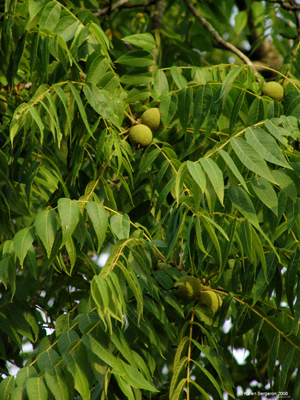Juglans nigra
| See Also | Botanical Monographs |
|---|
Black walnut (Juglans nigra) is best known for its use in treating parasitic and yeast infections yet is has a number of other uses as well. To explore the characteristics, medicinal uses and prescribing considerations of this herb in more detail, check out the references indicated.[1], [2]
Contents
Characteristics
- Common Names: Black walnut
- Family: Juglandaceae
- Habitat: Juglans nigra can be found north of Lake Erie, in warmer parts of Ontario, and in the eastern U.S.A.
- Parts Used: bark, leaves, and rind of the fruit
- Constituents: Naphthaquinones (juglone), fixed oils, volatile oils, tannins
- Medicinal Actions: antihelmintic, antibacterial, antiviral, laxative, astringent, hepatic (rind), detergent (leaves)
Uses
Historical Uses:
Juglans nigra was used by Native Americans and settlers as a laxative and tonic. In folk medicine, it was used for constipation (bark) and tapeworms (fruit oils) and for arthritis, headaches, and dysentery wounds. The green hulls of the nuts have also been used as dyes.
Medicinal Uses:
- Yeast infections, Candida, parasitic infections, laryngitis, sore throat, tonsillitis (bark), diarrhea due to an infection
- ring worm (poultice)
- Other Uses
- Stops lactation, leucorrhea, inflammation and cankers of the oral-cavity, cleansing wash (leaves), abrasions and cuts, high cholesterol, heart tonic
Prescribing Considerations
The information provided is intended to augment the treatment from a naturopathic doctor or other trained medical professional. Although most herbs are generally safe, it is recommended that you avoid self-prescribing especially when there is an underlying ongoing medical condition, if you are on any prescription medications or if you are pregnant or breastfeeding.
Formulations and Preparation
- Tea - 1 tsp of the bark/cup of water, daily, cold, a mouthful at a time
- Tincture - 1-15 drops three times daily
Safety
The safety and prescribing considerations for Black Walnut include: [3] [4]
- Generally regarded as safe for short-term use.
- Side-effects are generally not seen.
- Contraindicated for prolonged use (mutagenicity of juglone in animals)
- Drug-Herb Interactions. [2]
- The tannins found in the leaves and hull of Juglans nigra can selectively precipitate alkaloids and minerals.
- Inhibitor of liver clearance
- Induces glutathione s-transferase and NADPH-Quinone Reductase (DT-Diaphorase) activity
References
- ↑ Boon Heather, Smith Michael (2009) 55 Most Common Medicinal Herbs: The Complete Natural Medicine Guide Second Edition]] Institute of Naturopathic Education and Research, CCNM Toronto.
- ↑ 2.0 2.1 Godfrey Anthony, Saunders Paul, Barlow Kerry, Gowan Matt (2011) Principles and Practices of Naturopathic Botanical Medicine, Advanced Botanical Medicine. V3 CCNM Press, Toronto.
- ↑ Stargrove Mitchell Bebell, Treasure Jonathan, McKee Dwight L 2008 Herb, Nutrient and Drug Interactions: Clinical Implications and Therapeutic Strategies
- ↑ Brinker Francis 1997 Herbal Contraindications and Drug Interactions: Plus Herbal Adjuncts With Medicines, 4th Edition Eclectic Medical Publications.
